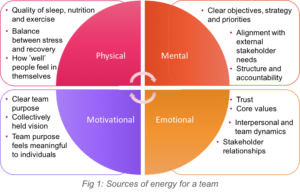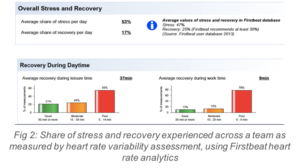The energised team
The changing world of work is placing higher demands on us all and the typical reaction we observe is that many people try to cope by pushing themselves harder and doing more. Unfortunately, with that they experience the detrimental physical and mental effects associated with working longer hours and feeling out of control. For the individual, the ultimate impact may be health-related; while organisations may feel the effects through poor decision-making, bottlenecks in workloads and poor delegation all leading to low levels of engagement, dysfunction in teams and lacklustre business performance.
Although the shifting work landscape may be challenging, there remains a choice for organisations to pivot from simply demanding more out of people and instead to looking at new ways to unlock motivation and discretionary effort – with benefits for all. As ways of working and organisations adapt, strategies for managing energy in teams will be a critical factor in supporting organisational goals of the future.
In two previous articles, we have explored how energy can be viewed and managed as a valuable business asset and 9 ways in which to lead energy management in your organisation. In our third article, we explore the sources of energy in teams to highlight some strategies for enhancing and sustaining this critical resource in businesses.
Previously, we illustrated a model to show where individuals derive their energy. The expanded model below depicts this through the lens of a team.

If we judge energy to be a source for creating desired performance outcomes, we can use the model to assess contextually, where a team is already strong and where focus and attention is needed to mitigate future risks to individual and business performance.
Contextual themes for managing energy in a team
Physical
The degree to which individual team members feel energised and able to give the best of themselves in service of team objectives will be partially determined by how physically well they feel. For a team to consistently fire on all cylinders, we need people to be healthy, rather than feeling “not ill, but not well”, which can result from sleeplessness, poor nutrition and inattention to our bodies’ needs for exercise and movement. One route to sustaining our physical and psychological health comes from being able to manage the balance between stress and recovery. In previous articles, we have highlighted the role of the autonomic nervous system (ANS) in this delicate balance for individuals. The relative dominance of two branches of the ANS can be measured through heart rate analytics and used to help individuals to understand their own personal physiological responses to stress and to develop strategies for managing this better. The same is true for teams where collective data can be aggregated to show how a whole team manages stress and recovery, as one component of its physical energy.

If an individual on the team is suffering from poor physical health, eventually the whole team will suffer. When even one person’s performance begins to flag, or an individual is struggling to manage stress, it will inevitably impinge upon the interpersonal dynamics in the team. In addition, the four sources of energy are inter-related. For example, where a lack of clarity around strategy results in confusion or uncertainty, this will disrupt the team’s mental focus, increase conflict between people, and drain emotional energy by diminishing the level of trust present.
Mental
For any team to function effectively, it needs clear strategy. It must be able to focus on both the big picture – the key objectives and priorities and the detail required to fulfill them. These might take the form of defined projects and associated action plans, as well as the team’s structure, roles and responsibilities. However, the internal components also need to be balanced with the needs of many external stakeholders and clearly it will benefit from agreeing shared expectations with those parties to increase alignment and collaboration.
Emotional
A key component of the emotional energy in a team comes from its relationships – the interpersonal relationships between team members, the dynamics of the team as a whole and its relationships with external stakeholders. To achieve commitment and engagement with all, people must have a felt connection to the purpose of the team, (see motivational theme), underpinned by a high level of trust between all parties. Patrick Lencioni’s model, The Five Dysfunctions of a Team, cites a lack of trust as one key source of team dysfunction.
Think of a time when you had a strong emotional reaction to something that someone else has said or done? It could be within a personal or work relationship or it could be an action taken by a larger body, such as a government’s decision to engage in war. The chances are that your reaction, positive or negative is directly connected to one of your core values. When values between people are aligned, then the team will experience more cohesion and less conflict. This is distinct from healthy and constructive conflict, which is necessary to confront issues and develop effective solutions.
Motivational
An inspiring and collectively felt sense of purpose is now a key component of every successful organisation today. A felt sense of purpose brings meaning to what we do, team members can fully apply themselves to tasks, which in isolation could be viewed as mundane if they are clear about why they are doing it. This is illustrated in the oft repeated story about President JFK asking a janitor at NASA what his job was, whilst sweeping the floor the janitor is said to have replied, “I’m putting a man on the moon, Sir”.
And finally, a clear and collectively held vision is a crucial source of motivational energy on a team. This is the sense of what the team could become or could deliver, if it is successful in fulfilling its purpose, in focusing on its strategy and from living and working in line with its core values.
The model we have illustrated provides four contextual themes through which to energise a lacklustre team or sustain existing high levels of performance. As a development tool, it can be used at a high level to determine which area requires greater focus and attention. Why not explore the model at your next team meeting and invite your team to share which aspects of the model is feeding their energy and which aspects are draining it – by listening to their perspective, you might be surprised and informed by their response.
If any of the ideas raised in this article spark curiosity, please don’t hesitate to get in touch to discuss further.
This post first appeared in Lewis Silkin LLP’s futureofworkhub on 25th November 2016.